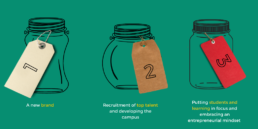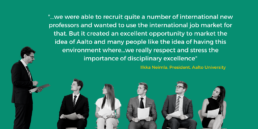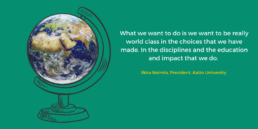Ask someone on the street to name a prestigious university they will often name institutions with a long, rich history, established hundreds of years ago. But there are numerous institutions all over the world, founded much more recently, that are hot on the heels of those historical, elite universities. One of those universities is Aalto University, Finland, formed in just 2010.
Ranked in the top 200 universities in the world (THE WUR 2021), Aalto University has broken the mould when it comes to what a university brand should look like. But it’s not just their visual identity that is striking; how they operate and how they have developed is also fascinating.
Formed from a merger of three universities in Helsinki, Aalto specialises in three key disciplines: science technology, business, and art and design. These disciplines are at the heart of Aalto University’s strategy and everything they do.
During the 2021 Young University Summit which took place in June, World 100 Director, Louise Simpson, spoke to Aalto’s president, Ilkka Neimla, about their success and growth over the last 11 years.
Illka stated that “When founded the idea was to create a new kind of university with a pioneering attitude and strong impact in the society, so instead of building that on the legacy and branding of the founding universities a completely new brand and name ‘Aalto university’ was created.”
The plan was not to become a large comprehensive university but to remain focused and build around the combination of the three disciplines and their close collaboration”, he continued.
- A new brand; based on focussing on the combination of three disciplines and their close collaboration for impact and innovation
- Employing increased autonomy of Finnish universities enabled by a major university reform in 2010 in particular to drive international recruit of top talent and developing the campus to become a globally attractive cooperation hub
- Putting students and learning in focus and embracing an entrepreneurial mindset and way of working

Our ‘Aalto University: Branding with Innovation’ piece explored the first of these. As for the second, Ilkka explained:
“In 2010, major university reform in Finland was launched which detached universities from the state and gave them more autonomy. Because of the reform it was possible to found Aalto as a private foundation-based university and this offered interesting possibilities such as in choosing career systems for personnel, having ownership of the campus properties and for fundraising and endowment…
Because we own our campus, we have been able to develop the campus systematically into a prominent collaboration hub that attracts partners widely and boosts collaboration – our campus is quite a unique place in Europe and the campus is one of the largest high-tech concentrations in Europe. In the middle of the campus is one of the best art and design schools in the world and one of the leading business schools in Europe. In fact, you do not have such a combination of the three disciplines collaborating closely together anywhere else in Europe.“
The recruitment of top talent was a defining part of Aalto’s strategy and the freedom that they gained from the afore mentioned university reform gave them the ability to achieve their goals.
“When we started we made a decision that it’s about people. So our biggest investment was actually, as a I mentioned, the adoption of the tenure track system for professors. And being very active in the international job market. Of course, we had an interesting situation where many of our professors were retiring so we were able to recruit quite a number of international new professors and wanted to use the international job market for that. But it created an excellent opportunity to market the idea of Aalto and many people like the idea of having this environment where, although we emphasis quite a lot the multi-disciplinary aspects, we really respect and stress the importance of disciplinary excellence and in creating an environment where these kinds of experts can work together in creative ways.’
But how can Aalto compete with older universities which have already attracted the world’s scholars and the best students due to their lasting reputation?
“Yes, that’s tough competition. When we were thinking about our faculty recruitment we realised that we need to be patient. The typical way of trying to boost your reputation is to try and recruit immediately the established world stars, you know the typical full professors, and we realised that that’s a very difficult game. So instead we targeted very much to young rising talents. And they had a very interesting opportunity to build their own careers in Aalto. And that has been a very successful strategy. We do now have a lot of talents and for example, nowadays we have a really large number of ERC grant holders which we didn’t have when we started. So the people that we recruited both know that they can work at Aalto and really get quite passionate about that. “

“For students, it is sort of interesting how things change but it is a slower process but still there it seems that peer testimonials; if you look at the decisions; how the decisions are made by the students of where to go and study, peer testimonials and these networks are more and more important and this is something we want to be good at so our students will have the best, exciting experience studying at Aalto and they will let that be known in their networks. “
Aalto’s campus, up and coming professors, and discipline-based approached meant that Aalto was able to then implement the third element; putting students and learning in focus and embracing an entrepreneurial mindset and way of working
“In education, the key idea has been to put the students and learning in focus. This has meant, for example, the strong development of problem and challenge-based learning at Aalto. Our flagship here has been our art and design factory as a platform for challenge-based learning. This concept has raised a lot of international interest and now there is an international network of over 30 design factories based on the Aalto model on five continents. Putting students in focus has also created a very active and empowered student body that really takes initiative. This has been perhaps the main driver for the entrepreneurial and way of working mindset at Aalto…”

One key area that Scandinavia as a region is known for is its relationship with the environment and its eco-friendly credentials. This topic is becoming more and more prominent in the higher education sector too. But does the age of Aalto and its Finnish location mean that impact, sustainability, and social responsibility are more dominant in their strategy? And is this something that young universities, in general, are more focussed on given that these objectives are becoming increasingly important to the next generation of students?
I don’t think it’s really the age but the ability to change or be dynamic is something that you need, Illka commented. “Because sustainability issues are something where you need systemic solutions, and you need sort of disruptive things. What was very interesting for us was when we shaped our new strategy, sustainability came very strongly from our faculty also and students, so actually Aalto is very much tuned for sustainability in all our operations and our teaching and learning. And in order to make this kind of change, I think that age and the agility that we have was a key factor that our faculty was looking for the really important, meaningful things, and sustainability was something that tied the faculty very much together and I think this is something we need to work together. Here the culture also plays a big role and collaboration is something that Aalto is built on that’s also very important for sustainability.
So with Aalto University making such waves in their 11 short years, what does the future hold for this innovative institution? Where does the university want to be in the next 5 years?
“What we want to do is we want to be really world-class in the choices that we have made. In the disciplines and the education and impact that we do. We are basically not targeting to be in a particular place in the general university rankings because we are not sort of driven by the rankings but our strategy. And so I’m sort of thinking that where we should be also in the rankings, let’s say subject-based rankings and those rankings that actually target the kind of things that we want to be so for example multi-disciplinary or sustainability. We want to be very much higher than what we are now., although we are actually quite high already at this point. So it’s a very tough game and of course, we need to remember that our resources and sort of basis are a little bit different than with the old players. But a step higher; the next level is my target.”

